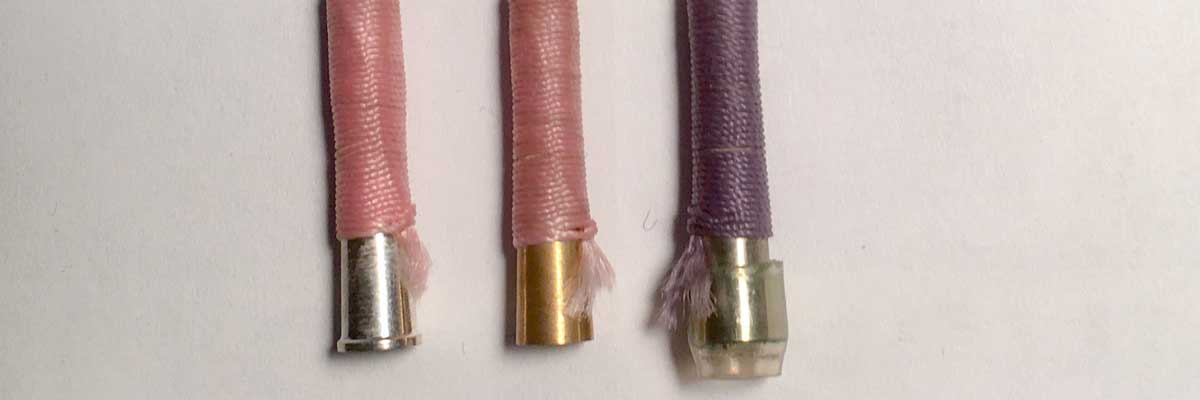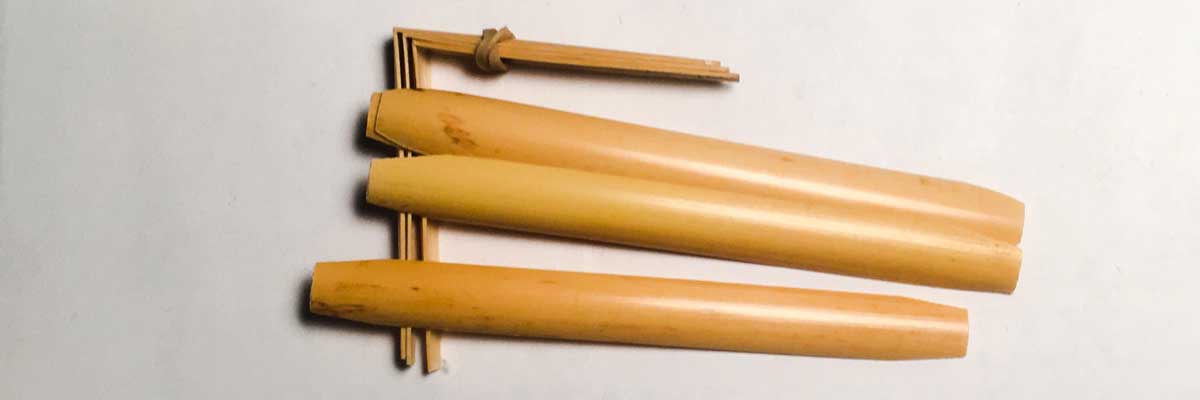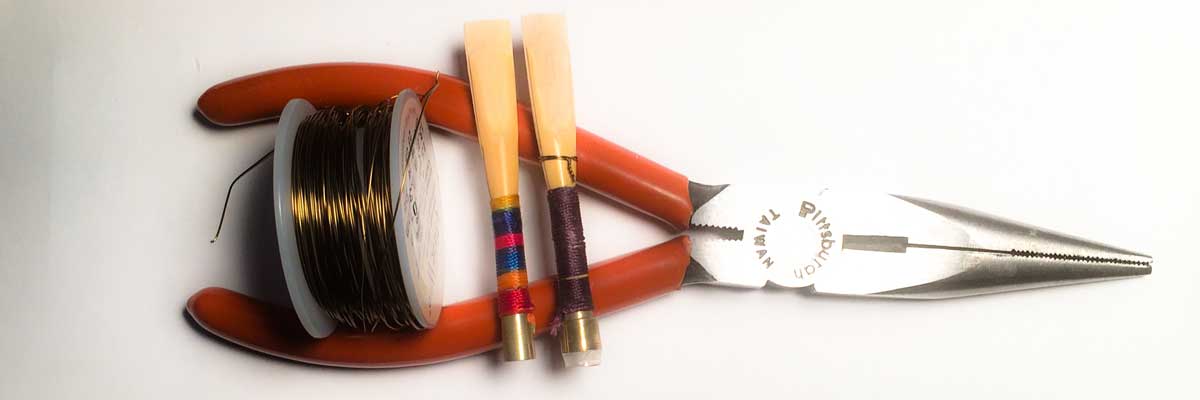The Ultimate Guide to English Horn Reeds
Several years ago a great English horn player came in and did a master class for our studio. He graciously provided a multi-page packet with everything you could think of related to the English horn. A few years later, I started to refine my own English horn reed-making process to best suit my personal needs. However, I found there wasn’t much in the way of information online to help guide me with the overwhelming number of shapes, staples, and troubleshooting issues. It is my hope to be able to shed some light on the different variables for oboists who are new to English horn reeds.
The information in this article is original and COPYRIGHT PROTECTED. Please feel free to use this information for personal use only, or contact me at khara@kharawolf.com for any other usage rights.
Material List for the Beginner: What you will need?
- EH staples
- An EH mandrel
- Shaped, Gouged EH Cane
- Thread and the rest of your usual materials
Tie Length and Tying Tips
The average tie length is about 60mm (measured from the bottom of the staple to the top of the cane). This should work well if you are using a middle of the road EH shape like RDG -1. If your shape is slightly more narrow you may find your reeds seal better at 59mm. And likewise, if you have a wider shape, try tying a little longer.
>> Pro Tip: Tying the thread at 26mm (just below the staple top)
On oboe reeds I’ve always tied my thread right at the top of the staple (at 47mm on a standard staple, but being careful not to tie over the top). I find you can tie your English horn reeds slightly below the staple. As long as the reed doesn’t leak, I’ve found this can help prevent issues.
This theory, in part, depends on the shape you are using and the staple width. The idea is, if the sides of the cane are being smashed together when you tie, this can cause pressure that will make the sides split open at the top (along with other issues like lack of vibration).
Another trick is to tie your reed slightly longer. As long as it doesn’t leak this will allow you to tie where the cane is a little more narrow.
Staple Types

There are various staple types including “with collar” and “without collar”, as well as brass, nickel, silver, and gold. Some of these variables will depend on your personal preference, and probably your bocal or your horn. Brass tends to be a little brighter and louder then silver and gold.
The collar is meant to help the reed stay on your bocal. If you are having problems, you can try no-collar staples that allow you to use English horn tubing to secure it on the bocal. Just make sure to play test the reed without the tubing as it will add a couple millimeters of length to your staple!
Another variable to consider is the size of the staple opening. Some staples have a wider opening then others. Keep in mind a wider staple with sit farther down on the bocal (and vise versa for a narrow staple). This may affect the pitch of the reed and/or how you need to scrape it.
>> What I use…
From some of the staples I’ve worked with, I found the RDG and Pisoni EH staples were more narrow then the Mark Chudnow CA staples. I ended up sticking with silver and nickel because I liked the slightly more mellow sound (my horn projects fairly well).
I also ended up going with a slightly wider staple opening (like the CA staples) because I felt, with my shape and tie length, I needed the extra width to avoid sides splitting open at the top. The wider staple also fit my bocal a little better.
Shaper Tips and Shape Sizes
This can be a tricky variable to balance. There are some charts online that compare a handful of tips, but everyone I talked to had several shaper tips in their collection.
The science behind the shaper size is similar to oboe reeds. A wider shape will be more open and have a darker tone, and a narrow shape will be more closed and have a slightly brighter sound. Something like the RDG -1 is probably a good place to start for those just getting going. Keep in mind some shapes will also respond differently depending on the gouge.
>> My set up…
I was using the RDG -1 shape, but even on various gougers I found the 11.5-12 reeds were too open and the 12-12.5 were too closed. I also felt that even when using the 12-12.5 diameter my reeds felt too heavy, too open at the bottom, and my high notes were sagging.
For my bocal and instrument, switching to a slightly narrow shape gave me a better opening and created a much more stable, flexible reed. I tried the RDG -1N (narrow shape), but felt the tone was too bright and the dynamics too limited. After comparing tip sizes between the -1 and -N1, I ended up going with the Jeanne Standard tip because those measurements gave me the best results.
>> Some Online Comparison Charts
- http://www.westwinddoublereed.com/compareoboeshapertips-27.html
- http://www.forrestsmusic.com/oboe_cane_shaping.htm
Cane & Gouge

This is another variable that will become a personal preference. It will also need to be balanced in relation to your whole setup. For oboists just starting out, I’d suggest ordering a few pieces of gouged cane from several different gouger types to see what works for you. I noticed a bit of a difference from one gouge to the next, but your demands will change depending on your complete setup.
Just like oboe cane, if you aren’t gouging your own cane, it can be hard to pinpoint the issues. You may be dealing with poor quality of cane and consistency issues with the gouger.
In my experience, the different types of gouged cane I tried primarily affected the opening of the reed, and how freely the reed vibrated. Even with any inconsistencies, you should be able to make some choices based on the different cane your order.
>> High Altitude Tip
If you are wondering where to start for elevation, I work mostly with the Ross gouger and RDG gouger. I was able to get consistent results on 11.5-12mm cane and felt it had the best opening and vibrations, both of which are key requirements for my high altitude reeds.
Wire

There is some debate on this topic as to whether or not the wire is helpful, or inhibits the vibrations. In general wire is used by players to stabilize the high notes and/or control the opening.
Because I feel using wire to control the opening affects the vibrations (key factor at high elevation), I only use wire to stabilize the high notes. I make it as tight as needed to keep it in place, but do not manipulate it further. If you are having significant issues with your opening, you may want to consider a different gouge, shape, or diameter cane.
The standard wire thickness or “gauge” is 26. Wire is typically applied right above the thread to help control the openings and stabilize high notes.
>> What I Use
I use a thinner wire (28 gauge) wire to stabilizes my high notes. At high altitude I felt like the 26 gauge was cutting off too much vibrations. Also, thinner (28 gauge) wire is a little easier to manipulate if you are learning to use wire for the first time.
Some Thoughts on High Altitude English Horn Reeds
The general principals of a high altitude oboe reed will apply to a high altitude English horn reed. The two variables are: the opening of the reed and how much the reed vibrates (both will affect response, pitch, and tone).
Diameter & Openings
Just like oboe reeds, you can use a smaller diameter of cane, 11.5-12mm. Depending on your shape and gouge (both of which affect the opening), you may find 12-12.5 still works just fine.
- If your reeds are too closed, but you otherwise like your set up, trying some 11.5-12 cane might do the trick.
- If your reeds are too closed and you also want a darker tone, try a wider shape.
- If your reeds are too closed and too stiff (hard or flat), try a narrower shape in combination with 11.5-12 cane.
- Option 3 is to change your gouge. Thicker sides will create a wider opening as well.
Cane Thickness & Scraping
Once you get above 5,000 feet, you may find you need to scrape a little more out of the channels of the heart and blend area to get the reed vibrating and lower the pitch.
Overall, the definitions between the back and heart might be slightly less defined as well. I find thick cane and a healthy opening help with the extra scraping.
If your openings are ideal, but your reed is loosing tone quality and dynamic range in the dry climate and high elevation, your cane may be too soft for the additional scraping. Try harder cane to retain more desired qualities.



Very nice article Kara! Good information for anyone trying to get started!
Very detailed and helpful. Until I get the hang of it I am purchasing reeds from another professional. I have determined what “hardness” works best for me, but wonder if I can salvage any of the ones that are too soft.
I’m glad you found the article helpful! You should be able to salvage some of the softer ones. They will probably just be limited in dynamics and maybe a little bright or buzzy compared to your “ideal” reed. As long as they are comfortable to play you should be able to get a little use out of them in an appropriate setting. I usually try to accommodate the softer cane with more “lower vibrations” from the back or blend of the heart to tip. Then clip the tip. Those adjustments will help darken the tone. And you may have to open the reed a little with the wire. I don’t like using the wire to control the opening, but it can help stretch out a soft piece of cane if it’s closing down. Good luck!
Khara, I love your site. When I moved to Denver I followed instructions I got from Dick White (Washington DC) many years ago, to get my reeds to work, and made a few adjustments of my own, and they are the same things you are saying here – imagine that! I do not wire reeds, but open and close them with pliars (described in Sprenkle).
Thank you Lila! I’m so happy to hear my site has been helpful (and that the information is similar to that which you have already found helpful too). I am interested in your suggestion of pliers – do you use them on the cane itself?